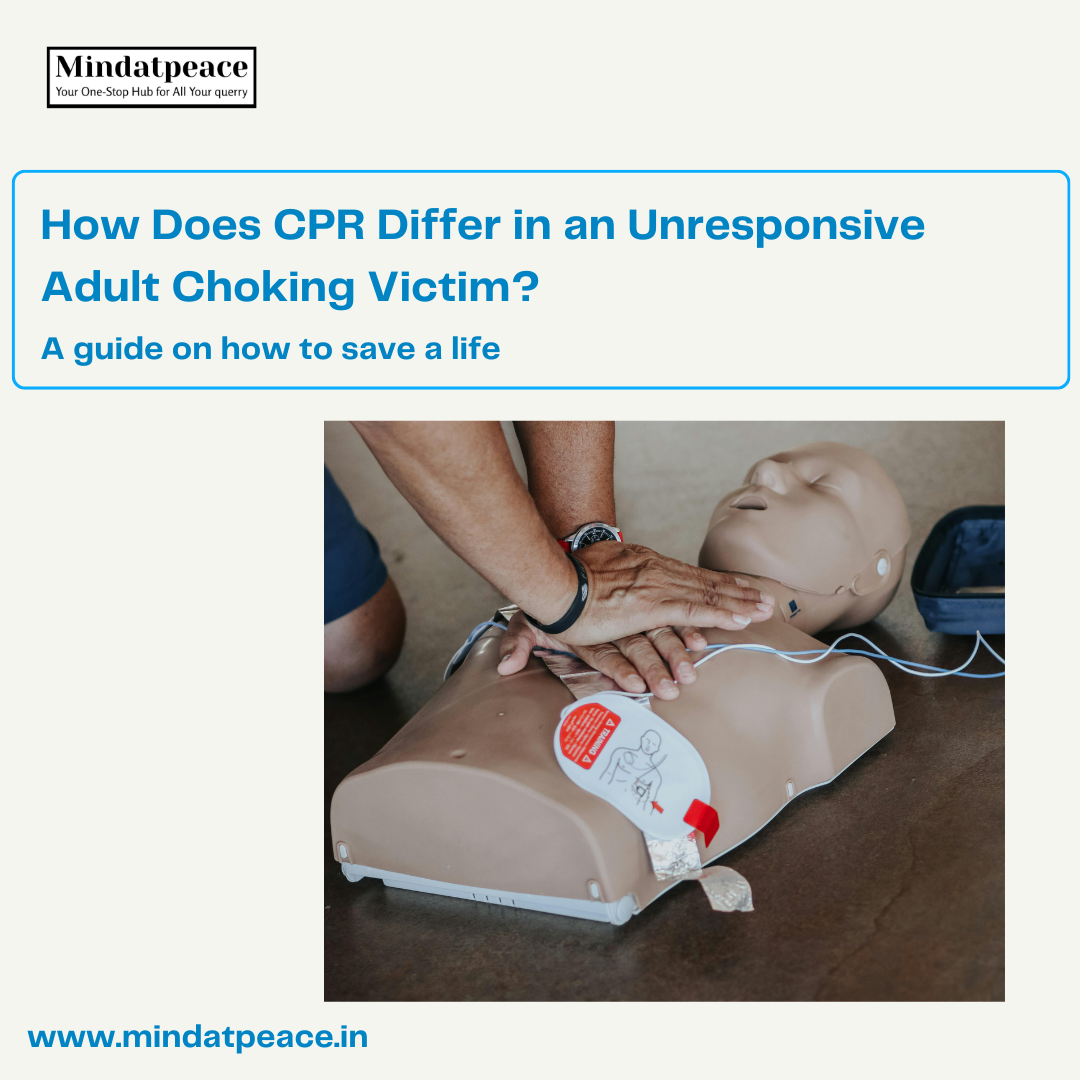Introduction to CPR and Choking
Cardiopulmonary Resuscitation (CPR) stands as a crucial life-saving technique deployed during emergencies, especially in instances of cardiac arrest or respiratory distress. Choking, a prevalent emergency, occurs when an object obstructs the airway, hindering breathing. How Does CPR Differ in an Unresponsive Adult Choking Victim Acquiring a deep understanding of CPR’s intricacies in such scenarios can make all the difference in preserving lives.
Understanding CPR for Unresponsive Adults
CPR, a crucial life-saving technique, fulfills the critical role of maintaining blood circulation and oxygenation to essential organs in instances where an individual’s heartbeat or breathing ceases. When dealing with an unresponsive adult facing choking hazards, CPR necessitates tailored adjustments to effectively clear the airway obstruction and restore normal breathing patterns. It stands as a beacon of hope in dire situations, offering a chance at survival and recovery for those in need.
Differences in CPR for Unresponsive Adult Choking Victims
In the critical scenario of aiding an unresponsive adult who is choking, the application of CPR techniques demands swift and precise adaptations to swiftly remove the obstruction obstructing the airway. How Does CPR Differ in an Unresponsive Adult Choking Victim The paramount objective shifts to promptly and effectively clearing the air passage, paving the way for the subsequent implementation of conventional CPR procedures. This tailored approach underscores the urgency and efficacy of CPR interventions in saving lives during moments of crisis.
Basic CPR Techniques
In the realm of life-saving techniques, standard CPR stands as a beacon of hope, combining chest compressions and rescue breaths to revive individuals in distress. Yet, when faced with a choking victim, the urgency shifts to clearing the airway swiftly. Employing techniques like abdominal thrusts or back blows takes precedence, ensuring the obstruction is promptly removed before initiating the crucial chest compressions. This tailored approach underscores the efficiency and adaptability of CPR, reaffirming its pivotal role in emergency response protocols.
Special Considerations for Choking Victims
In the critical moments of a choking incident, nothing surpasses the urgency of swiftly clearing the airway. Employing proven techniques like the renowned Heimlich maneuver or modified abdominal thrusts stands as our foremost line of defense. These maneuvers, honed through years of medical expertise, swiftly expel obstructing objects, offering a lifeline to those in distress. By prioritizing airway clearance, we pave the path for restored breath and renewed hope in the face of adversity.
CPR Training and Certification
Mastering CPR isn’t just about understanding the concept—it demands proper training and certification. CPR courses offer more than just theoretical knowledge; they immerse individuals in hands-on instruction, ensuring proficiency in proper techniques. By completing these courses, individuals not only gain the skills necessary to respond effectively to emergencies but also become invaluable assets in critical situations. Investing in CPR training is investing in the ability to save lives.
Common Misconceptions About CPR and Choking
Dispelling misconceptions about CPR and choking is paramount in fostering accurate understanding and rapid response during emergencies. By debunking myths and providing factual information, we empower individuals to act confidently and effectively when faced with critical situations. Promoting accurate knowledge not only saves lives but also builds a community of informed and prepared individuals ready to lend a helping hand when it matters most.
When to Perform CPR
Understanding the signs of cardiac arrest and distinguishing choking incidents are pivotal steps in determining the necessity for CPR. By being vigilant and knowledgeable about these indications, individuals can promptly spring into action when needed, potentially saving lives in critical situations. This awareness emphasizes the importance of CPR education and preparedness in our communities, empowering people to act swiftly and confidently during emergencies.
Legal and Ethical Considerations
Good Samaritan laws provide crucial protection to individuals who administer CPR in good faith, underscoring the moral obligation to offer aid in emergency scenarios. By offering legal immunity, these laws encourage bystanders to take action without fear of repercussions, thereby increasing the likelihood of timely intervention and potentially saving lives. Emphasizing the importance of these laws reinforces the notion of community responsibility and underscores the significance of prompt and decisive action during crises.
Preventive Measures
Recognizing choking hazards and proactively implementing safety precautions are vital steps in reducing the risk of choking incidents. By identifying potential dangers and taking preventive measures, individuals and communities can create safer environments for everyone, especially children and vulnerable populations. Emphasizing the importance of vigilance and safety measures underscores our commitment to health and well-being, ensuring that everyone can enjoy life without unnecessary risks.
Community Awareness and Education
Promoting awareness about CPR training and educating people about the risks of choking cultivates a proactive attitude toward emergency preparedness in communities. By empowering individuals with the knowledge and skills to respond effectively to emergencies, we create safer environments and increase the likelihood of saving lives. Encouraging CPR training and highlighting the dangers of choking underscores the importance of community readiness and underscores our collective responsibility to keep each other safe.
CPR and Choking in Special Circumstances
Customizing CPR techniques to cater to individuals with health conditions or disabilities is crucial for fostering inclusivity in emergency response protocols. By acknowledging and addressing diverse needs, we ensure that everyone, regardless of their health status or abilities, receives the necessary assistance during critical situations. Embracing inclusivity not only promotes equality but also strengthens our collective capacity to effectively respond to emergencies and support those in need.
Post-CPR Care and Follow-Up
Vigilantly observing the victim’s condition following CPR and promptly seeking medical assistance are pivotal steps in guaranteeing the best possible recovery outcomes. By maintaining a watchful eye on the individual’s well-being and swiftly involving professional medical support, we enhance the chances of a successful and swift recovery. This commitment to thorough post-CPR care underscores our dedication to ensuring the highest standards of emergency response, providing reassurance and support to those in need.
Real-Life CPR Success Stories
Highlighting real-life scenarios where CPR interventions have been pivotal emphasizes the critical importance of comprehensive CPR training and readiness initiatives. By showcasing instances where CPR has made a life-saving difference, we underscore the urgency for widespread education and preparedness in communities. These examples serve as compelling evidence of CPR’s effectiveness and the profound impact it can have in emergencies, inspiring individuals to become trained and empowered responders.
Conclusion
In conclusion, it’s critical to delve into the intricacies of CPR concerning unresponsive adult choking victims for a truly effective emergency response. By immersing oneself in comprehensive training and understanding the nuances of proper techniques, individuals can step up as invaluable lifesavers in crucial moments. Armed with this knowledge, they become the frontline heroes capable of making the critical difference between life and death. Explore more on Mindatpeace. How Does CPR Differ in an Unresponsive Adult Choking Victim.
Frequently Asked Questions (FAQs)
Q. What are the key differences between CPR for unresponsive adults and children?
A. The key differences between CPR for unresponsive adults and children lie in the application of force during chest compressions and the method of rescue breaths. For adults, chest compressions are deeper and performed with two hands, while for children, chest compressions are shallower and performed with one hand or two fingers.
Q. Can CPR cause harm if performed incorrectly on a choking victim?
A. Yes, CPR can cause harm if performed incorrectly on a choking victim. Improper techniques may lead to injuries such as broken ribs or punctured lungs. It’s crucial to receive proper training and follow the recommended procedures to minimize the risk of harm.
Q. Are there age restrictions for individuals seeking CPR certification?
A. There are generally no age restrictions for individuals seeking CPR certification. Anyone, regardless of age, can undergo CPR training and certification as long as they are physically capable of performing the necessary techniques.
Q. How can workplaces promote CPR training among employees?
A. Workplaces can promote CPR training among employees by organizing CPR certification courses on-site or providing access to external training programs. Offering incentives or rewards for employees who undergo CPR training can also encourage participation and increase overall workplace preparedness for emergencies.
Q. What should I do if a choking victim becomes responsive before emergency services arrive?
A. If a choking victim becomes responsive before emergency services arrive, it’s important to monitor their condition closely and continue providing support until professional help arrives. Even if the victim appears to recover, it’s advisable to seek medical evaluation to ensure no internal injuries or complications exist.




